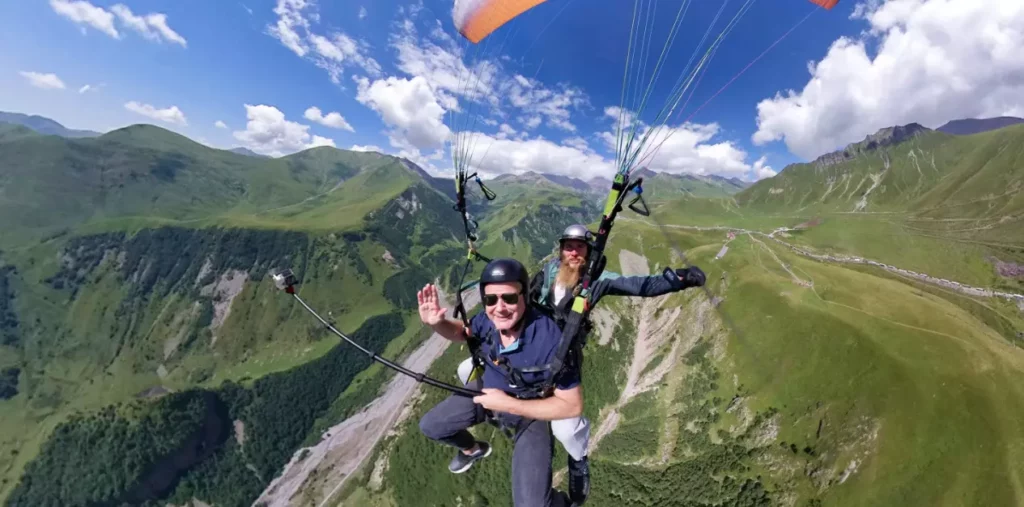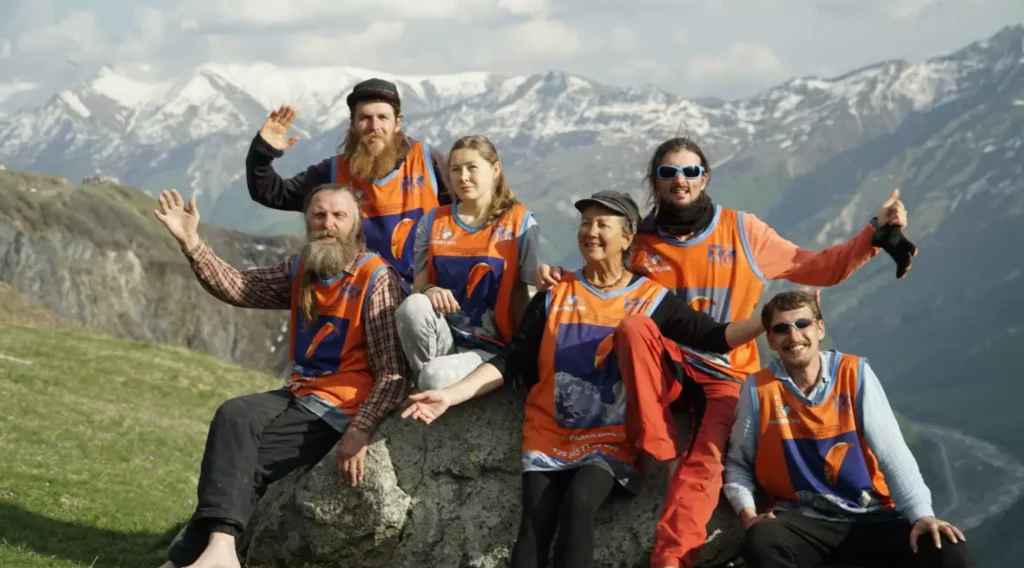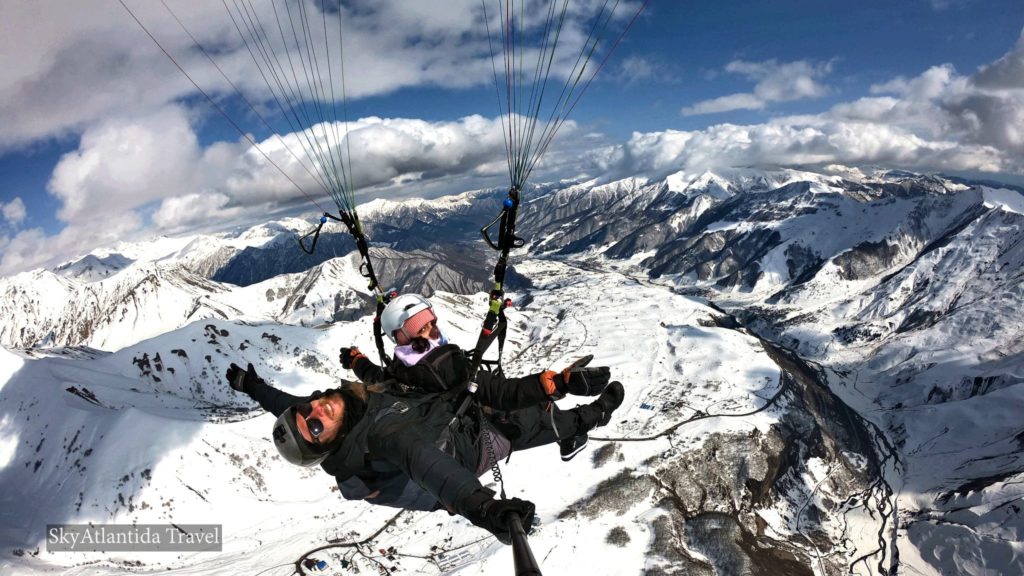
Where to paraglide in Georgia
“Once you feel happiness in the air, you will always keep reaching for the heights”
© Вlack Opium
Flying a paraglider is one of the simplest and safest way to reach the sky, to feel incredible emotions of free floating, to see the world the way birds see it, as well as to feel free from earth’s gravity. Someone uses this method to overcome their fear of heights. Knowledge of aerodynamic laws helps pilots take off and fly a paraglider without a motor or complicated technical equipment. For those who wanted to but had no courage to try for a long time, we’ll tell you how and why the paraglider flies.
What is a paraglider
A Paraglider is ultralight aircraft which was developed on the base of a parachute wing. The name “paraglider” derives from two words “parachute” and “gliding”. The paraglider is designed as a soft wing with internal ducts used for distributing air pressure evenly on the wing. More than 250 metres of slings divided into several rows for shaping the wing as well as slings for controlling the paraglider.
Comfortable harness system equipped with a reserve parachute and everything you need for a safe and comfortable multi-hour flight.
The paraglider wing is designed for horizontal flight, an experienced pilot can fly more than 550 km when the weather is favourable, flying above 8 000 metres.
In July 2021 Antoine Girard set a new record at 8 407 meters. Paragliding belongs to ultralight aviation and it is the most available, democratic and compact form of aviation. Ultralight equipment can be packed in a 60-litre backpack. Paragliding equipment weighs between 5 and 25kg, depending on the configuration, design, size and density of the materials used.
In good flying weather you can take off with a paraglider from almost any hill, mountain and, having an auxiliary winch and kilometre-long rope, from any field or dirt road. It is not necessary to have an airfield or a special landing site: a small flat surface, for example, a grassy lawn with no obstacles measuring 50m by 50m or more, will be enough.
How a paraglider flies
The paraglider takes off and floats in the sky due to the air flow. When taking off, the pilot turns to face the wind and places the wing behind him. Then begins the run-up, the paraglider fills with air and takes a shape, a couple of steps and there it is, real freedom!
Aerodynamics
The forward movement of a paraglider is driven by the gravity of the earth, thus maintaining airspeed. The flight characteristics of the glider directly depend on the glider’s aerodynamic capabilities. What affects speed, descent rate and the flight efficiency is the glide path. The glider flies due to upward air flows that are divided into – dynamic, thermal, and thermodynamic. The movement of air masses on the planet is caused by solar activity.
Dynamic flow occurs when the wind faces an obstacle in its path, after that it changes the direction from horizontal to vertical. You can fly through the dynamic flow when the vertical wind speed is higher than the glider’s rate of descent. This type of flight is quite predictable, clear and is used by schools when teaching young cadets. In dynamic upward flow pilot will not be able to fly far away from the mountain slope and in case of decrease of wind speed he will not be able to stay within the line of dynamic flow. In addition, the maximum altitude at which one soars in dynamic flows strongly depends on factors such as wind direction in relation to the slope, its ascent and altitude.
Thermal upward flows are generated by the sun warming the earth’s surface. The earth warms unevenly, depending on the angle of sunlight and the texture of the underlying surface. Therefore, air temperature is changed, resulting in an unstable atmosphere. Warm air expands and flows upwards. It is in the thermal upward flows that one can see the advantages of the paraglider compared to other aircraft. Small spiral radius in upward flow allows the glider to easily ‘jump’ into narrow flow and gain altitude in places where this is almost impossible with a hang glider or a glider. The extended speed range from 25 to 65 km/h gives gliders the confidence to fly long distance crossings. Thermals are the most common types of upwinds used for route flights with a paraglider. Experienced pilots move from one thermal flow to the next one, soaring towards the clouds and overcoming incredible distances.
Thermo-dynamic upward flow results from the occurrence of the background wind at the same time as the solar activity.
This is the principle on which route flights and paragliding route competitions are based.
Flying a tandem paraglider with an instructor is possible in any of the upwinds listed above and even if there are no upwinds at all, the presence of upward flows affects the altitude and duration of the flight. Tandem flights are available to almost everyone, except for small restrictions on weight and age of the passenger, do not require special training and are 99% safe to fly with experienced instructor pilots.
It is complicated to learn to feel and predict the wind, flying a paraglider in thermodynamic upward flows. The pilot should understand the sky and learn to get information about our environment. The ability to find upward flows, gain altitude and make transitions is a real art. Where there is thermal activity, there is also turbulence, which pilots have to deal with expertly. Despite the difficulty of flying in thermal flows It’s no secret for many people that in the mountains, the sun’s warmth creates its own microclimate and perfect conditions for route flying together with birds. Flying along route pilot tries not to have a specific location and flight altitude is restricted by inversion, relief and altitude of upward flows along planned route and by pilot’s skill, of course. Therefore, the best sites for paragliding are based in warm countries with lots of sun, mountains and abundance of landing sites.
And what can be better than mountains? It is only mountains of beautiful Georgia, where the team SkyAtlantida would be happy to give you the most unforgettable moments of your life – flying a paraglider. You can see the beauty of Georgia from the bird’s eye view, to feel unforgettable emotions, to feel freedom from earth’s gravity. Strong feeling of flying, real emotions, safe and levity.
Menu
Contacts
- +995 55 13 55 000
- skyatlantidabooking@gmail.com
- Georgia, Gudauri, New Gudauri block 1, floor 1, office 114.


